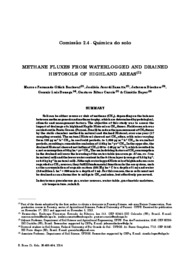Methane fluxes from waterlogged and drained histosols of highland areas.
Methane fluxes from waterlogged and drained histosols of highland areas.
Autoria: RACHWAL, M. F. G.; ZANATTA, J. A.; DIECKOW, J.; DENEGA, G. L.; CURCIO, G. R.; BAYER, C.
Resumo: Soil can be either source or sink of methane (CH4), depending on the balance between methanogenesis and methanotrophy, which are determined by pedological, climatic and management factors. The objective of this study was to assess the impact of drainage of a highland Haplic Histosol on CH4 fluxes. Field research was carried out in Ponta Grossa (Paraná, Brazil) based on the measurement of CH4 fluxes by the static chamber method in natural and drained Histosol, over one year (17 sampling events). The natural Histosol showed net CH4 eflux, with rates varying from 238 ?g m-2 h-1 CH4, in cool/cold periods, to 2,850 ?g m-2 h-1 CH4, in warm/hot periods, resulting a cumulative emission of 116 kg ha-1 yr-1 CH4. In the opposite, the drained Histosol showed net influx of CH4 (-39 to -146 ?g m-2 h-1), which resulted in a net consumption of 9 kg ha-1 yr-1 CH4. The main driving factors of CH4 consumption in the drained soil were the lowering of the water-table (on average -57 cm, vs -7 cm in natural soil) and the lower water content in the 0-10 cm layer (average of 5.5 kg kg-1, vs 9.9 kg kg-1 in natural soil). Although waterlogged Histosols of highland areas are regarded as CH4 sources, they fulfill fundamental functions in the ecosystem, such as the accumulation of organic carbon (581 Mg ha-1 C to a depth of 1 m) and water (8.6 million L ha-1 = 860 mm to a depth of 1 m). For this reason, these soils must not be drained as an alternative to mitigate CH4 emission, but effectively preserved.
Ano de publicação: 2014
Tipo de publicação: Artigo de periódico
Unidade: Embrapa Florestas
Palavras-chave: Gases de efeito estufa, Nível freático, Precipitação pluviométrica, Temperatura do ar, Umidade gravimétrica, Água
Observações
1 - Por padrão são exibidas publicações dos últimos 20 anos. Para encontrar publicações mais antigas, configure o filtro ano de publicação, colocando o ano a partir do qual você deseja encontrar publicações. O filtro está na coluna da esquerda na busca acima.
2 - Para ler algumas publicações da Embrapa (apenas as que estão em formato ePub), é necessário ter, no celular ou computador, um desses softwares gratuitos. Sistemas Android: Google Play Livros; IOS: iBooks; Windows e Linux: software Calibre.
Acesse outras publicações
Acesse a Base de Dados da Pesquisa Agropecuária (BDPA) para consultar o acervo completo das bibliotecas da Embrapa.

